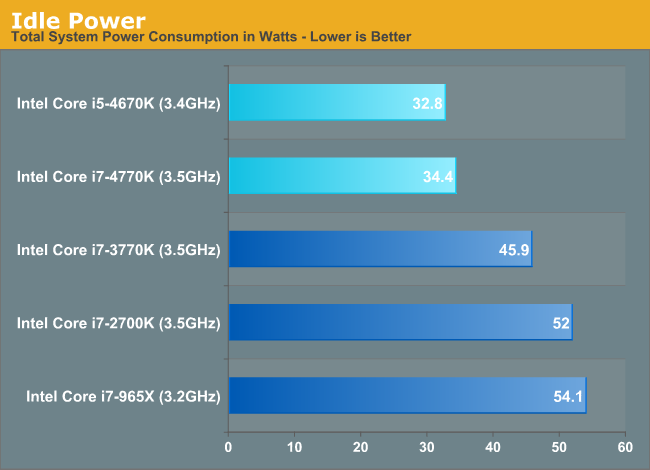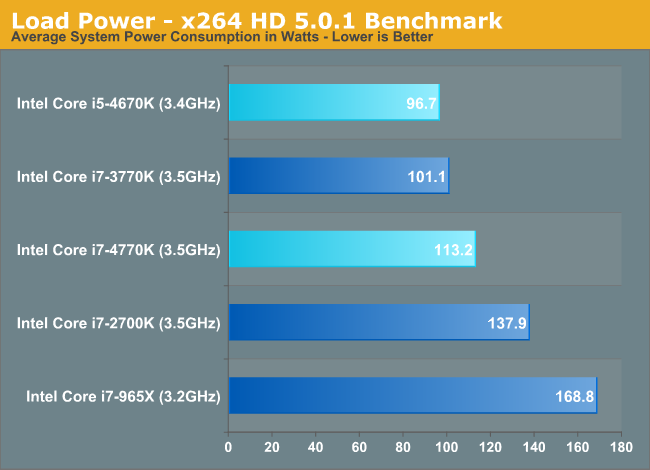The Haswell Review: Intel Core i7-4770K & i5-4670K Tested
by Anand Lal Shimpi on June 1, 2013 10:00 AM ESTPower Improvements
Although Haswell’s platform power is expected to drop considerably in mobile, particularly with Haswell U and Y SKUs (Ultrabooks and ultrathins/tablets), there are benefits to desktop Haswell parts as well.
There’s more fine grained power gating, lower chipset power and the CPU cores can transition between power states about 25% quicker than in Ivy Bridge - allowing the power control unit to be more aggressive in selecting lower power modes. We’ve also seen considerable improvements on lowering platform power consumption at the motherboard level as well. Using ASUS’ Z77 Deluxe and Z87 Deluxe motherboards for the Haswell, Ivy and Sandy Bridge CPUs, I measured significant improvements in idle power consumption:

These savings are beyond what I’d expect from Haswell alone. Intel isn’t the only one looking to make things as best as can be in the absence of any low hanging fruit. The motherboard makers are aggressively polishing their designs in order to grow their marketshare in a very difficult environment.
Under load, there’s no escaping the fact that Haswell can burn more power in pursuit of higher performance:

Here I’m showing an 11.8% increase in power consumption, and in this particular test the Core i7-4770K is 13% faster than the i7-3770K. Power consumption goes up, but so does performance per watt.
The other big part of the Haswell power story is what Intel is calling FIVR: Haswell’s Fully Integrated Voltage Regulator. Through a combination of on-die and on-package circuitry (mostly inductors on-package), Haswell assumes responsibility of distributing voltages to individual blocks and controllers (e.g. PCIe controller, memory controller, processor graphics, etc...). With FIVR, it’s easy to implement tons of voltage rails - which is why Intel doubled the number of internal voltage rails. With more independent voltage rails, there’s more fine grained control over the power delivered to various blocks of Haswell.
Thanks to a relatively high input voltage (on the order of 1.8V), it’s possible to generate quite a bit of current on-package and efficiently distribute power to all areas of the chip. Voltage ramps are 5 - 10x quicker with FIVR than with a traditional on-board voltage regulator implementation.
In order to ensure broad compatibility with memory types, there’s a second input voltage for DRAM as well.
FIVR also comes with a reduction in board area and component cost. I don’t suppose this is going to be a huge deal for desktops (admittedly the space and cost savings are basically non-existent), but it’ll mean a lot for mobile.
No S0ix for Desktop
You’ll notice that I didn’t mention any of the aggressive platform power optimizations in my sections on Haswell power management, that’s because they pretty much don’t apply here. The new active idle (S0ix) states are not supported by any of the desktop SKUs. It’s only the forthcoming Y and U series parts that support S0ix.










210 Comments
View All Comments
smoohta - Saturday, June 1, 2013 - link
Blah, seems like a rather shallow review:1. What about benchmarks to take advantage of the new AVX2 instructions? (FMA specifically would be interesting)
2. Same for TSX?
Klimax - Sunday, June 2, 2013 - link
I know only about x264 having it in the last versions. Not sure who else has it.Gigaplex - Saturday, June 1, 2013 - link
"Here I’m showing an 11.8% increase in power consumption, and in this particular test the Core i7-4770K is 13% faster than the i7-3770K. Power consumption goes up, but so does performance per watt."So... performance per watt increased by ~1%. For a completely new architecture that's supposedly all about power optimisation, that's extremely underwhelming to say the least.
Homeles - Saturday, June 1, 2013 - link
Haswell is not focusing on the desktop I'm not sure how you managed to believe that it is.krumme - Saturday, June 1, 2013 - link
Because Anand is a fan of it, even at desktop?MatthiasP - Saturday, June 1, 2013 - link
So we get +10% performance increase for +10% increase in energy consumption? That's rather disappointing for a new generation.jeffkibuule - Saturday, June 1, 2013 - link
Haswell is movinig voltage regulators that were already on the motherboard on die, so power consumption hasn't changed, it's just that the CPU cooling system has to deal with that extra heat now. Remember that those power ratings are NOT about how much power the chip uses, but how much cooling is needed.Homeles - Saturday, June 1, 2013 - link
System power consumption with Haswell is, in fact, higher. Take a look at page 2.Still, when you're running at these kind of frequencies, 10% more performance for 10% more power is a big deal. If you were to hold back the performance gains to 0%, power savings would be greater than 25%.
The only reason Piledriver was able to avoid this was because it was improving on something that was already so broken. AMD's not immune to the laws of physics -- when they catch up to Intel, they will hit the same wall.
Klimax - Sunday, June 2, 2013 - link
Most likely sooner, because they can't fine tune process.dgz - Saturday, June 1, 2013 - link
I agree but Intel has been doing that for many years. I just don't get what they're gaining by artificially restricting IOMMU support.